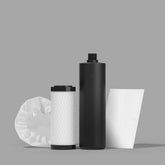Bacteria Basics
Bacteria are the smallest (1-10 micron in length and 0.2 -1.0 micron in width) and simplest, single celled organisms that can live independently (no host required!) since they have all of the biochemical equipment required for metabolism. Despite their small size, the total weight of all bacteria in the world likely exceeds the weight of all other organisms combined. Bacteria consists primarily of a cellar material contained within a cell wall. The properties of the outer cell walls differ, which provides the most common method of distinction between a Gram negative, which has a multi-layered cell wall and outer membrane, and a Gram positive, which has a single thick layered cell wall. Bacteria also come in different shapes such as spheres (cocci), spirals (helical), cylinders (rods) or in no defined shape - which are called pleomorphic. Bacteria cells are usually found in clumps or chains known as colonies.
In order for bacteria to survive and grow it requires the following; nutrients (food), water, and a source of energy. With these three ingredients bacteria can multiple very rapidly - as often as every 20 minutes. They have incredible survival skills, can adapt to almost any type of environment, and can survive under some of the most extreme conditions.
Most bacteria are harmless and are used in the production of medicines, foods and functional enzymes however, some bacteria can causes disease in humans. These are referred to as pathogens or pathogenic bacteria. Enteric bacterial pathogens (those found in the digestive tracts of animals - including humans) are of the greatest concern when dealing with water related issues. When enteric bacterial pathogens are ingested they compete with normal intestinal cells for nutrients and they secrete toxins that can cause a variety of symptoms (mild to severe) and can cause a wide range of diseases. Of course, bacteria can also enter the body through skin exposure or respiratory exposure from a shower or fountain aerosols....a subject to be reserved for a later discussion.
Testing for the presence of bacteria is straight-forward but because there are so many different illness causing bacteria it not practical to test for each of them individually. So, indicator organisms are often used in testing. In drinking water testing there are typically three types of bacterial tests performed; heterotrophic plate count (HPC), E. coli ( a subset of fecal coliform), and coliform (CFU).
The Heterotrophic plate count (HPC) method measures a broad spectrum of bacteria and, because it is not specific to any one bacteria, high HPC cannot be directly correlated to the presence of pathogens. What it does offer is an indication of the biological quality of the water supply being tested. As a general rule, a reading of greater than 500 Colony Forming Units (CFU) indicates corrective measures should be taken.
Testing for the presence of Fecal Coliform or E. Coli is also used. Since E. coli bacteria comes from the intestinal track of warm blooded animals, a positive test result is a strong indicator of the presence of bacterial contamination (from human or animal waste) in the water supply.
Coliform is also a good testing option, because a positive result is an indicator of the possible presence of harmful bacteria.
The biggest difference between the two (coliform and E.coli) is that coliform, unlike E.coli, is naturally present and plentiful in the environment as well as in the feces of warm-blooded animals. E. coli comes from human and animal fecal waste and is not naturally present in the environment.
Bacteria typically has four phases of growth. Stage one is the lag phase - a period when the bacteria becomes accustom to its environment. Bacterial growth is very slow during the lag stage. Stage two is called the log phase - the phase where the bacteria has adapted to its environment and, where the conditions are conducive to growth, that growth is very rapid. As the bacteria population multiplies and gets larger, competition for food becomes an issue that negatively impacts growth. As the growth rate slows down we enter phase three - the stationary phase. During this phase toxins in the growth environment build and the food supply dwindles, culminating in the transition to phase four - the death phase. Phase four is labeled the death phase because the bacteria literally begin to die off due to the shortage of nutrients. However, as the bacteria die off they become an available nutrient source for remaining bacteria - and the growth cycle starts again.
Although we tend to focus a great deal of our attention on pathogenic (disease causing), bacteria we have to stop and remind ourselves that more than 90% of all known bacteria are considered beneficial, or least harmless, to humans. They spend their days breaking down organic matter and help to destroy harmful parasites.
We know it is impossible to cover the full scope on the topic of bacteria in a single article we only hope you find some of the information we provided useful. Powerful antimicrobial chemicals (also known as disinfectants) are increasingly found in household cleaners, from laundry detergent to kitchen cleaners to handy wipes and are also used in water 'purification' devices. Yet research has shown that some of the most common antimicrobial chemicals could have serious health consequences. Exposure to these chemicals has been linked to potential health impacts from simple irritation of the skin, eyes, and respiratory systems to hormone imbalance, immune system impacts, asthma, and potential reduced fertility. The overuse of disinfectant chemicals also contributes to the growing problem of antibiotic-resistant bacteria, more commonly known as “superbugs.”
OutbackWater is pleased to offer non-chemical water treatment devices designed to remove or deactivate dangerous microorganisms to effectively disinfect and/or purify water - whether for your consumption or for use in your home or business.
- Choosing a selection results in a full page refresh.





